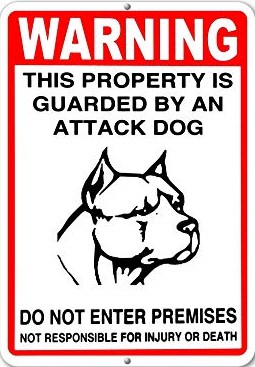When Dogs Attack: Part 1 – Who is Responsible?

In Canada, a dog owner may be liable for injuries their dog inflicts on another person. A person who is attacked by a dog may sue the dog’s owner in law, specifically in tort law. Tort law was created and developed by the courts to address both intentional and unintentional acts that cause injury to another person.
How Can a Dog’s Owner be Held Responsible for Its Actions?
In Canada, there are 2 primary ways to hold a dog owner responsible for injuries that their dog inflicts on another person:
1) the doctrine of scienter; or
2) the law of negligence.
1) Doctrine of Scienter – Dogs That are Known to Bite
Scienter is the Latin word for knowledge. Under the doctrine of scienter, a person will be held liable for injuries caused by their dog if:
1) they own the dog;
2) the dog previously demonstrated a tendency to bite; and
3) the owner knew of that tendency.
The doctrine of scienter applies to situations in which a dog’s owner knows that it has bitten or attempted to bite people in the past. If this is the case, the owner will be held liable for compensating a person who is injured by the dog’s bite, even if the owner is not negligent in the care or control of the dog. This means that owners of dogs that are known to bite must take extraordinary care to ensure that the dog is not able to bite and to warn people that the dog may bite, whether or not the dog is on a leash or otherwise contained.
2) The Law of Negligence
What if the dog has never bitten someone before, but suddenly attacks and injures someone? The courts have long held that dog owners and people who have care and control of a dog have a duty to ensure that their dog is not likely to injure another person or their property. Failing to comply with this duty could be considered negligent.
However, before a person will be found liable in negligence for a dog biting another person, it must be proved that the dog owner:
1) knew or ought to have known that the dog was likely to bite another person;
and
2) failed to take reasonable steps to prevent the dog from biting another person.
The test is not whether the owner anticipated that the dog would cause the extent of the injuries caused by the bite, but whether the owner could have reasonably foreseen that the dog would bite someone. If it is reasonably foreseeable that a dog may interact with another person and may bite that person, the owner must take steps to prevent the dog from biting another person. This could take the form of warning other people that the dog may bite, keeping the dog on a short leash, or even muzzling the dog.
What is the Difference Between the Doctrine of Scienter and Negligence?
The main difference between the doctrine of scienter and negligence is that scienter applies only to dog owners, whereas negligence applies to whomever has care and control of the dog at the time of the attack.
Restricted or Dangerous Dog Breeds
It is important to note that the courts in Alberta have held that an owner of a dog that is designated as “restricted” or “dangerous” under local bylaws only on account of its breed, will not be liable under the doctrine of scienter only because of the dog’s breed. The owner must know that the dog demonstrated a tendency to bite.
For example, if a city has designated Pit Bulls as a restricted or dangerous breed under its animal control bylaws, and a Pit Bull bites someone, the owner of the Pit Bull is only liable under the doctrine of scienter if they knew that the dog had a tendency to bite.
What if the Dog Owner Posted “Beware of Dog” Signs on Their Property?
A dog owner can still be held liable for injuries their dog causes to people who were invited or permitted to be on their property, pursuant to the Occupiers’ Liability Act, RSA 2000, c O-4.
Posting a warning sign is not sufficient under the Act, unless the warning is enough to ensure the visitor’s safety. For example, posting a “Beware of Dog” sign on the fence before hosting a backyard barbeque will not ensure visitors’ safety unless the dog is actually kept away from the visitors.
What if Someone Approaches the Dog Without Asking?
It is important to note that the person in control of the dog need only take reasonable steps to prevent the dog from biting another person. If, for example, a person approaches a dog without asking and is subsequently bitten, they could be found to have been contributorily negligent.
If an injured person’s negligence contributed to the injuries suffered as a result of another person’s negligence, the amount of compensation awarded for their injuries will be reduced by the percentage for which they contributed to their own injuries.
What if the Person in Control of the Dog Violates an Animal Control Bylaw?
Violating an animal control bylaw does not, by itself, prove that the person in control of the dog was negligent, but it can provide some evidence that the person was negligent.
Who Pays for Injuries Caused by a Dog?
Dogs are typically considered to be the property of a homeowner. Therefore, most home insurance policies provide coverage for injuries caused by a dog bite. This coverage applies even when the bite occurs off the homeowner’s property. However, not all home insurance policies provide coverage for dog bites, and many policies specifically exclude certain breeds of dog from coverage.
Tenants insurance may also cover injuries caused by a renter’s dog. Dog owners can also purchase umbrella liability insurance to cover injuries caused by their dog.
What if the Dog Owner is Uninsured?
If a dog injures a person and the owner is not covered by a valid insurance policy, they may be sued personally. This may be problematic, because the dog owner may be unable to fully compensate the injured person for their injuries and there will be no insurance company to step in and pay.
What Should I Do if I Have been Bitten by a Dog?
• Seek immediate medical attention if necessary;
• Call the police and make a report;
• Obtain a copy of the police report;
• Get the name and contact information of the dog owner;
• Get the names and contact information of any witnesses;
• Document the incident – the type of dog, location, date and time, details of the attack;
• Take pictures of your injuries – and if possible – of the dog;
• Report the incident to the appropriate animal control authority; and
• Contact Moustarah & Company for a free initial consultation.
Look for Part 2 of this series: When Dogs Attack: WHAT HAPPENS TO THE DOG
The information provided on this website does not constitute legal advice and should not be construed as such. Moustarah & Company does not guarantee that this information is accurate or up to date. As a result, should you require legal advice, please contact a personal injury lawyer.

